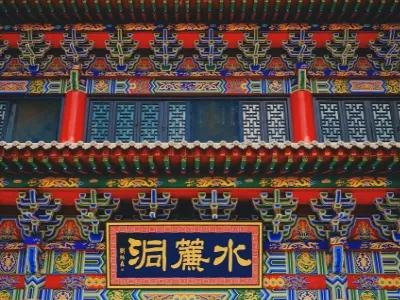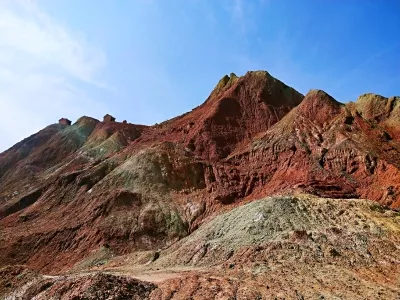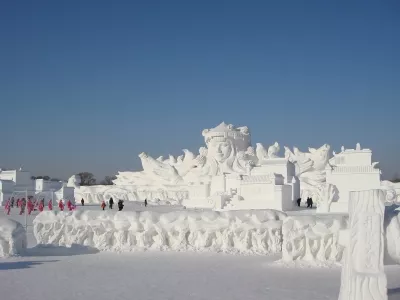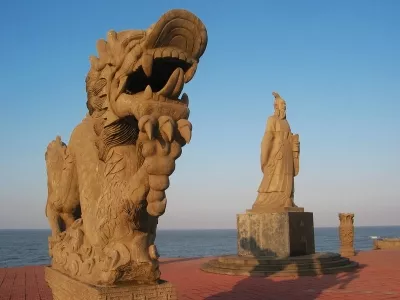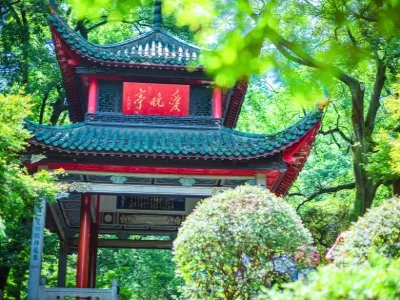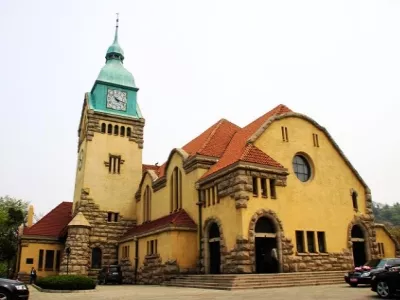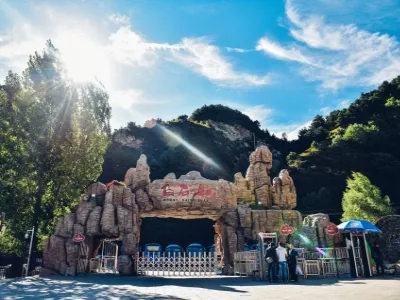Gannan Tibetan Autonomous Prefecture is located in the southwestern part of Gansu Province, bordering Qinghai and Sichuan provinces. It belongs to the Ankang Tibetan area, with Hezhou being its capital city. As an important component of the Silk Road and the Tang-Tibet Ancient Road, Gannan not only boasts vast and beautiful plateau scenery, but also has a rich Tibetan Buddhist cultural style, making it a place with both beautiful scenery and rich cultural heritage. In the heaven-like Holy Land of Gannan, the grasslands are filled with the fragrance of butter, the sound of Tibetan debate in Larung Gompa follows the smoke rising, Langmusi is like a world-like paradise, and the source of the White Dragon River sends out an ancient call. The people who walk around the prayer wheels with six syllable mantras and full of faith, as well as those who prostrate and kowtow on the road, bring us spiritual shock.
Hezhou: The capital city of Gannan Tibetan Autonomous Prefecture. There are several buses directly connecting Hezhou with Lanzhou, Xiahe Larung Gompa, and Luqu Langmusi.
Xiahe: Plays a very important role in Gannan tourism. Larung Gompa is a famous attraction here. Most tourists to Gannan will choose Xiahe as a transfer point.
Larung Gompa: Larung Gompa is a representative tourist attraction in Xiahe County, Gannan Tibetan Autonomous Prefecture. It is ranked among the six major Gelug monasteries in Ankang and is a religious center in Ankang Tibetan areas.
Langmusi: The town's name of Langmusi has the reputation of "Oriental Switzerland". The town is divided into Gan and Chuan halves by the Baolongjiang River (a small stream), with north banks belonging to Gansu Luqu and south banks belonging to Sichuan Ruoergai.
Bank
Typing…January Prayer Great Dharma Meeting
From the 3rd to the 17th day of the first lunar month, Tibetan Buddhist monasteries across Gannan host Grand Prayer Ceremonies, marking the most lively time of year in the region. Tibetans dress in colorful brocade robes and precious jewelry for the rituals. Daily ceremonies involve six prayer sessions with all monks chanting sutras. Other highlights include Releasing Lives Day on the 8th, Displaying Buddha Day on the 13th, religious dance on the 14th, butter lamp displays on the 15th, and Circling Maitreya on the 16th. For those interested in Tibetan folk arts and religion, visiting Gannan during Monlam provides a vivid immersion in sacred rituals. Tip: On Displaying Buddha Day, abbots lead processions carrying giant thangka scrolls of embroidered Buddhas to outdoor platforms for public viewing and chanting. During Monlam, Labrang Monastery opens all halls to visitors free of charge. The candle-lit butter lamp displays on the 15th are not to be missed. Circling Maitreya on the 16th features a masked dance accompanying the parading of the Maitreya Buddha statue that visitors can touch for blessings.
Dajiutan Jockey Club
On the 13th day of the seventh lunar month each year, nomadic tribes of the Sangke Grasslands gather on the sweeping pastures of Dajutan for the annual horse racing competition. Twenty to thirty young equestrians between the ages of 6 and 12 represent their families in various races. To compete in the festival is considered an honor among the nomads. On race day, crowds line the hillsides to cheer on the pint-sized jockeys as they gallop at full speed across the flower-dotted meadows. Horses and riders are adorned in colorful garlands and saddles embellished with tassels and embroidered motifs. Judges assess not only speed, but the skill with which riders guide their steeds. Visitors can take in displays of horsemanship, lasso spinning performances, and enjoy local cuisine. For both participants and spectators, the lively Dajutan festival offers a window into the competitive spirit, expert equestrian skills and rich cultural traditions of the nomadic herders.
Fragrant Wave Festival
The aromatic Xianglang Festival is a romantic celebration rich in Tibetan culture and entertainment. Held in Tibetan villages and monasteries from early to late June according to the lunar calendar, the festivities feature traditional activities that showcase the vibrancy of nomadic life. Horses and yaks decorated in floral headdresses compete in races to demonstrate the herders' expert horsemanship and animal husbandry skills. Crowds cheer on test-of-strength competitions like tug-of-war and wrestling. Locals also participate in running races, singing, and dancing in traditional costumes. The sound of music fills the air as people young and old swing and stomp to folk songs passed down through generations. Visitors can sample authentic Tibetan barley wine, sweet tea, yak butter treats and sizzling barbeque while immersing themselves in the festival's unique blend of competition, courtship and cultural celebration. For both Tibetans and tourists, the delightful Xianglang Festival offers a feast for the senses and a window into enduring nomadic traditions.
Niannai Festival
The Nangai Festival is a solemn Tibetan Buddhist observance held from the 14th to 16th day of the fourth lunar month. At dawn on the 14th, villagers gather in communal prayer halls to hear lamas recite aspirational words, chant the six-syllable mantra, and share a vegetarian meal before heading to monasteries to spin prayer wheels. On the 15th, locals continue spinning wheels, reciting mantras and meditating in seclusion while observing a strict fast from food and water from sunrise to sunset. The fast is broken the next morning. For visitors, this is an opportune time to witness sacred rituals in Gannan's Tibetan Buddhist monasteries and experience the spiritual essence of Tibetan culture. The fervent prayers and mantras echoing across the land create a palpable collective spirit and tranquil atmosphere, allowing one to reflect on the deeper meaning behind this time of purification.
Arrow Insertion Festival
From the first to the last day of the fourth lunar month, the Choijin, or Arrow Inserting, Festival sees Tibetans converging on sacred mountains to insert arrows as offerings. Dressed in traditional garb, riders bearing bows and ornamental arrows climb slopes blowing conch shells. Reaching altars amidst fluttering prayer flags, they chant and insert arrows into tall cairns before performing rituals like burnt juniper offerings. The mountain echoes with sounds of arrows hitting targets, horse hooves, and victorious shouts. For visitors, the colorful processions and solemn rituals immerse you in mystical Tibetan customs tied to nature worship and warding off evil spirits. Choijin provides a window into the spiritual worldview of Tibetan herders, who have relied on the sanctity of the land’s rocky peaks and grasslands for centuries. Marvel at the scale and atmosphere of rituals that transform holy sites into centers of power and protection for the coming year.
At sunset, enjoy the panoramic view of Labrang Temple
After crossing the Daxia River, make the steep climb to overlook Labrang Monastery in all its glory. From this vantage point, the sea of golden-roofed temples and academies is breathtaking. The jewel-bright gilded tower of Gongtang Pagoda shimmers in the distance. At dusk, monks can often be seen relaxing and debating scripture in small groups across the hillside. There is no better place to watch the sunset over Labrang than from this lofty perch. As the sun dips behind the mountains, its fading rays set the red walls and gilded roofs ablaze, creating an ethereal glow across the entire monastery complex. Or arrive early to admire the first light of dawn creeping across the temples and fluttering rows of prayer flags. Labrang is mesmerizing at any hour, but during the liminal hours of sunrise and sunset, its beauty achieves perfection.
Take a turn around the longest turning corridor in the country
Labrang Monastery is one of the holiest sites in Tibetan Buddhism, renowned for its academic rigor. While its fame has skyrocketed since the filming of ‘The World Without Thieves’ here, Labrang remains a sacred pilgrimage destination. No visit is complete without walking the entire 3.5 km scripture corridor, the longest in China. Join pilgrims and monks circling clockwise around the monastery while turning the countless religious scripture wheels built into the walls. Feel the devotion as worshippers murmur prayers and prostrate themselves around you. Trace your fingers over ancient scrolls and etchings darkened by thousands of reverent touches. As you continually walk, contemplate the monks' ascetic life of study and sacrifice. Completing the lengthy kora path crowded with devotees deepens your understanding of Labrang’s significance. One full loop around this magnificent corridor immerses you in Tibetan spiritualism and the perseverance of faith.
Hiking in the Namo Canyon to Find the Source of the Bailong River
Just south of Langmu Monastery stretches an 8-km long canyon with rugged cliffs and meadows waiting to be explored on foot. This is Namu Canyon, and deep within lies the origin of the White Dragon River flowing through Gannan. Follow the riverbanks out of Gertse Monastery’s iron gates and within minutes, you’ll enter the lush canyon. The river sparkles over stones as you begin your hike, with increasing challenges and rewards ahead. After a few hours, the water vanishes underground, giving way to spectacular stone forests sprouting from the canyon floor. Let your eyes roam over the constantly shifting geological formations while searching for the mythical source. Wandering deeper into Namu Canyon’s pristine landscape, with the possibility of discovering the elusive headwaters, is an adventure unique to Gannan’s awe-inspiring wilderness.
Best Travel Time
June to August is the best time to travel to Gannan. At this time, the average temperature in Gannan is 10-20 ℃, which is the warmest time of the year. The grass is lush, wild flowers are everywhere, and the grassland is lush and colorful, making it the best time to enjoy the beautiful scenery of the plateau. In addition, during the prayer ceremony from the third day of the first lunar month to the seventeenth day of the first lunar month, there are various Tibetan themed festivals that take turns. This is a great time for friends who are interested in Tibetan culture and folk customs to not miss.Customs taboos
Two unique Tibetan traditions persisting in Gannan are pilgrimage circuits and sky burials. Circumambulation, or walking clockwise around temples or mountains while chanting and spinning prayer wheels, is believed to accumulate merit. Each rotation equals reciting the six-syllable mantra venerating Buddha. More repetitions demonstrate piety and progress one’s reincarnation.
Sky burials also reflect Tibetan Buddhist philosophy. After death, the body is dismembered and fed to vultures that are considered sacred embodiments. Consuming corpses enables spirits to ascend while completing the cycle of rebirth. Though confronting to outsiders, these rituals retain deep meaning for Tibetans. Visitors should observe respectfully, not photograph ceremonies without permission or interfere with centuries-old customs. While fascinating to experience authentic regional heritage, cultural sensitivity remains paramount when encountering Gannan's spiritual traditions.
Self driving
Driving in Gannan, Gansu
Overall the roads in Gannan are in good condition. Major highways include:
- National Highway 213 running north-south, connecting Linxia and Sichuan
- Provincial Highways 310, 311, 312, 313 running east-west, connecting Qinghai and Longnan
Gannan's first expressway from Lanzhou to Hezuo is expected to complete in 2015. The Lanzhou to Linxia section is already open.
Attractions in Gannan are quite spread out. Gas stations are limited, mainly PetroChina, and many don't have unleaded gasoline.
When self-driving in Gannan, be prepared for long distances between sights, lack of services, and bringing your own supplies. The scenery is worth the effort, but do proper planning, have extra fuel and food, and drive cautiously on mountainous highways. An adventurous, self-reliant spirit will be rewarded with incredible vistas and Tibetan culture in this remote region.
Medical treatment
Here are some key emergency numbers and contacts for Zhangye for an English travel website:Emergency Information for ZhangyeZhangye Tourism Hotline: 0936-8211684Zhangye Tourism Complaint Number: 0936-8229595Linze County Tourism Bureau: 0936-5520699Police Emergency: 110Fire Emergency: 119 Medical Emergency: 120Traffic Accident: 122Police SMS Reporting: 12110Weather Forecast: 12121Red Cross First Aid: 999Save these important numbers in your phone in case of any emergencies during your trip. The tourism hotlines can also provide assistance and information.For medical issues, you can directly contact the hospitals:- Zhangye People's Hospital: 0936-8213411- Ganzhou District Hospital: 0936-8213411Stay safe and enjoy your time in Zhangye! Let us know if you need any other travel information.Safety considerations
Travel Tips for Gannan, China:
1. High altitudes up to 12,800 ft can cause altitude sickness. Allow time to acclimatize and avoid overexertion. Descend and seek medical attention if symptoms persist.
2. Be cautious around Tibetan mastiffs and large dogs when hiking or visiting villages. Don't approach without owner consent.
3. Some locals carry knives - avoid any conflicts and don't escalate misunderstandings. Prioritize safety.
4. Bring breakfast if taking early buses to avoid motion sickness.
5. Langmusi sky burials may expose remains - use discretion if queasy.
6. Shops are scarce in Xiahe - pack ample food, water and medications.
Gannan offers immense natural beauty and Tibetan culture, but requires preparedness. Gradually adjust to the altitude, steer clear of intimidating dogs, and keep your wits about you. With common sense, this high-altitude destination promises memorable adventures.



